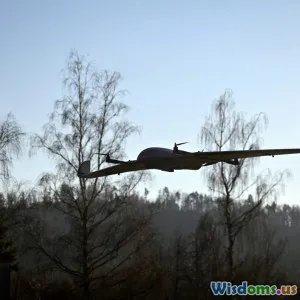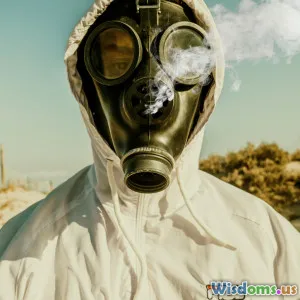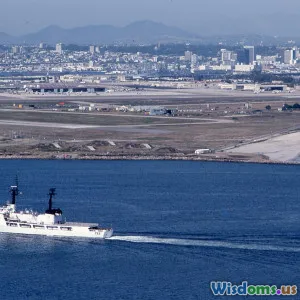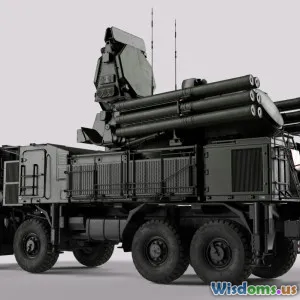
How Nations Protect Critical Infrastructure from Cruise Missile Strikes
10 min read Explore how nations shield vital infrastructure from cruise missile threats using advanced defenses and strategic protocols. (0 Reviews)
How Nations Protect Critical Infrastructure from Cruise Missile Strikes
In an era marked by rapid advancements in warfare technology, the threat posed by cruise missile strikes on critical infrastructure remains one of the most pressing concerns for national security worldwide. These weapons, characterized by their low-altitude, terrain-following flight paths and precision targeting abilities, have the potential to inflict severe damage on power plants, communication hubs, transportation networks, and military installations. Given their stealth and accuracy, cruise missiles demand sophisticated defensive measures and strategic planning to ensure vital infrastructure remains secure.
Understanding the Threat: Why Are Cruise Missiles So Dangerous?
Cruise missiles combine several features that make them particularly menacing:
-
Low-Altitude Flight: Unlike ballistic missiles, cruise missiles fly close to the ground or sea surface, often using terrain-following radar to evade radar detection. This low profile means traditional early-warning systems might only detect them when it's nearly too late to respond.
-
Precision Strikes: Equipped with advanced guidance systems, including GPS and inertial navigation, they can hit targets with incredible accuracy, minimizing collateral damage but maximizing infrastructural disruption.
-
Stealth and Speed: Some varieties have stealth coatings and fly at subsonic speeds, making them harder to track on radar. Others may reach supersonic speeds, reducing reaction times for defenders.
These attributes position cruise missiles as favored tools in modern warfare, especially for states or non-state actors seeking to cripple adversaries effectively with minimal exposure.
Section 1: Detection and Early Warning Systems
The first and arguably most vital step in defending critical infrastructure is early detection. Without timely warning, defensive measures are far less effective.
Radar Systems and Advanced Sensor Networks
Modern radar installations are designed to detect low-altitude, slow-moving objects against clutter. Multifrequency radars, phased array systems, and Over-the-Horizon (OTH) capabilities significantly extend detection ranges.
For instance, the United States' AN/TPY-2 radar utilized in the Aegis Ballistic Missile Defense System has been calibrated to track cruise missile signatures alongside ballistic targets. Likewise, the Russian Container radar is a long-range system specializing in low-altitude object detection.
Beyond radar, nations use sensors including electro-optical/infrared (EO/IR) cameras, acoustic sensors, and satellites, creating a sensor fusion approach. This layered sensor methodology enhances detection fidelity and mitigates individual system vulnerabilities.
Use of AI and Machine Learning in Target Recognition
Artificial intelligence plays a growing role in differentiating genuine cruise missile threats from false alarms. Algorithms analyze incoming data streams in real-time, identifying telltale patterns of cruise missile flight behavior.
For example, Israel’s Iron Dome system incorporates AI modules for threat assessment, rapidly prioritizing targets for engagement. Although primarily for shorter-range threats, similar AI-enhanced detection principles apply in cruise missile surveillance to improve response times.
Section 2: Multi-Layered Missile Defense Architectures
Once a threat is identified, nations rely on a hierarchical network of defenses to intercept or neutralize cruise missiles before they reach their target.
Layer One: Electronic Warfare and Jamming
Electronic countermeasures (ECM) disrupt the missile's navigation and targeting systems. Jamming GPS signals or radar homing can cause missiles to miss their intended targets.
In conflicts such as Syria, Russian forces deployed ECM against hostile cruise missiles to degrade guidance accuracy. While ECM does not physically destroy the missile, it often forces it off course or prevents lock-on, offering time for other defenses to engage.
Layer Two: Surface-to-Air Missiles and Anti-Aircraft Systems
Ground-based missile systems remain the backbone of cruise missile defense. Systems like the U.S. Patriot PAC-3, Russia's S-400 Triumf, and the Israeli David's Sling are designed to engage low-flying, high-speed targets.
Patriot PAC-3: With its hit-to-kill technology, PAC-3 interceptors are capable of destroying cruise missiles mid-flight. During the Gulf War in 1991, Patriot batteries markedly reduced damage inflicted by Iraqi Silkworm cruise missiles.
S-400 Triumf: Russia’s advanced SAM system can track multiple cruise missiles simultaneously and engage them at ranges up to 250 kilometers.
Layer Three: Point-Defense Systems and Directed-Energy Weapons
Short-range air defenses fill the last line of protection, often deploying rapid-fire guns, short-range missiles, and emerging laser technologies.
For example, the U.S. Navy’s Close-In Weapon System (CIWS) uses radar-directed rapid-fire 20mm Gatling guns to neutralize cruise missiles approaching naval vessels. Such systems are being adapted for land-based critical infrastructure defense.
Directed energy weapons, such as high-energy lasers, offer promise for affordable and endless ammunition countermeasures. Countries like China and the U.S. have made significant strides in testing laser-based interceptors suitable for countering cruise missile swarm attacks, though many remain in developmental stages.
Section 3: Hardened Infrastructure and Redundancy
Defense does not merely rely on intercepting missiles in flight. Protective architecture ensures infrastructure resilience against attacks that may breach initial defenses.
Physical Hardening
Critical facilities, including power plants, communication hubs, and government centers, are often reinforced with blast-resistant materials. Underground vaults, steel-reinforced concrete, and earth berms help mitigate damage from blasts.
For example, France’s nuclear power plants are designed to withstand external attacks, including missile strikes, with active cooling systems housed underground to prevent catastrophic failure.
Redundancy and Distributed Networks
To prevent catastrophic service failures, many nations design critical systems to be redundant. Distributed energy grids, multiple communication exchange points, and alternate transportation nodes reduce the impact of localized attacks.
The U.S. Department of Energy promotes microgrid technology enabling localized energy generation and self-reliance, reducing outage vulnerability caused by missile strikes on centralized power plants.
The European Union’s investments in Resilience Strategy emphasize diversified infrastructure to withstand targeted strikes and sabotage.
Section 4: Intelligence, International Collaboration, and Strategic Deterrence
Protection also depends on anticipatory intelligence and diplomatic efforts that reduce threat likelihood.
Intelligence and Threat Assessment
Early awareness of adversary capabilities and intentions allows nations to prepare defenses or conduct preemptive countermeasures. For instance, tensions in the Indo-Pacific have spurred enhanced monitoring of missile procurements and drills by near-peer adversaries, enabling timely upgrades to defensive protocols.
International Security Initiatives
Countries often collaborate through intelligence sharing, joint exercises, and missile defense partnerships. The NATO Integrated Air and Missile Defence System (NATINAMDS) provides collective security by coupling sensor and weapon systems across member states, enhancing cruise missile threat response.
Strategic Deterrence
Strong retaliation doctrine and advanced strike capabilities may dissuade adversaries from attempting cruise missile attacks. Nations maintain credible deterrence through visible military strength and diplomatic messages emphasizing consequences of infrastructure targeting.
Conclusion: The Continuous Evolution in Defense Against Cruise Missiles
As technology evolves, so too do the tactics used to threaten critical infrastructure via cruise missiles. Today’s defense paradigms merge detection, interception, physical hardening, and strategic foresight into a comprehensive security approach. From highly advanced radar and AI analytics to multilayered missile systems and reinforced infrastructure, nations employ an interconnected shield designed for resilience and rapid response.
However, the threat landscape remains dynamic. Emerging hypersonic missiles, drone swarms, and cyber vulnerabilities inject new challenges. To keep pace, countries must continually innovate, invest in research, and nurture international cooperation.
For policymakers, defense planners, and citizens alike, understanding the complexities of protecting critical infrastructure from cruise missile attacks conveys the urgency of sustained efforts. Ensuring national stability and public safety depends on it—an imperative that transcends borders and echoes across all strategic domains.
Rate the Post
User Reviews
Popular Posts



















